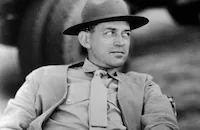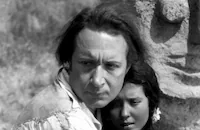White Shadows in the South Seas

Brief Synopsis
Cast & Crew
W. S. Van Dyke
Monte Blue
Raquel Torres
Robert Anderson
William Axt
John Colton
Film Details
Technical Specs

Synopsis
Lloyd, a drunken, demoralized white doctor who defends a tribe of Marquesan natives against the greed of Sebastian, an unscrupulous trader, is unjustly accused of a crime and tied to the wheel of a plagued ship that is set adrift. The vessel is wrecked in a typhoon, and Lloyd is washed ashore on an island where the natives, who have never seen a white man before, revere him as a god. Sebastian's trading schooner anchors offshore, and Lloyd pleads with the natives to keep Sebastian and his men off the island; the natives do not heed his advice, however, and Lloyd is shot to death by one of Sebastian's crew. With Lloyd out of the way, Sebastian is free to set up a trading post, cheating the natives and ruining their lives with bad whiskey.

Director

W. S. Van Dyke
Crew
William Axt
John Colton
John Colton
Jack Cunningham
Clyde De Vinna
Ray Doyle
Dave Dreyer
Robert Flaherty
Ben Lewis
David Mendoza
George Nagle
Bob Roberts
Herman Ruby

Film Details
Technical Specs

Award Wins
Best Cinematography
Articles
White Shadows in the South Seas
Rumor has it that Thalberg bought Frederick O'Brien's book because he found the title intriguing and not because of its powerful story which was a bitter denunciation of white civilization and its destructive effects on the lifestyles and cultural traditions of a Polynesian paradise. The central focus of White Shadows in the South Seas is Matthew Lloyd (Monte Blue), an alcoholic doctor who is shanghaied by an unscrupulous pearl trader and winds up being marooned on a Pacific island where the natives have never seen a white man before. As time passes, Lloyd is revered as a god but eventually his corrupt nature and inherent greed brings about the destruction of the island community through alcohol, lust, and disease.
Flaherty agreed to direct White Shadows in the South Seas because he was friends with the author Frederick O'Brien and was recognized as an expert on Pacific Island culture (He had spend over 20 months on the island of Savai'i in the Somoas filming Moana). Van Dyke was brought on board to head up the technical unit and the entire crew traveled to the island of Papeete in Tahiti for filming. Right from the beginning, things began to go wrong. The unit's interpreter was arrested a day after the crew arrived due to a past run-in with the local authorities. That situation immediately made the islanders suspicious of the movie people. Complicating the situation were tropical downpours that delayed filming, a climate that quickly spoiled food and basic edibles, and the unavailability of portable lights and generators for location shooting. And Flaherty's slow, meticulous method of filmmaking was trying the patience of the entire crew. In W. S. Van Dyke's Journal, the assistant director wrote, "Everyone hates everyone else's guts. They are fighting like mad. Flaherty doesn't know a thing....I have never seen a troop in a more deplorable condition. I am spending my days running around trying to pat them on the back and telling them to carry on as we will get home all the quicker. They are not sore at me, and when I am shooting they behave alright, but the minute Flaherty starts in, they start."
Flaherty knew his attempt to create a natural, ethnographic portrait was doomed when he came upon his disinterested crew members sitting on the sand, listening to a radio concert broadcast from the Coconut Grove, a popular Hollywood nightclub. Even though the natives were singing Polynesian songs in the nearby coconut grove, the crew were only interested in returning home. Reportedly, Flaherty said in disgust, "Why not go back and make the picture in the Coconut Grove?" He soon quit the production and returned home to Hollywood leaving MGM to frantically try and salvage the film.
Van Dyke was soon promoted to director and successfully rallied the troops to complete the filming in Tahiti. Back on the MGM lot at Culver City, he shot some additional material for White Shadows in the South Seas including a typhoon at sea and a shipwreck. Then the studio decided to make White Shadows in the South Seas their first sound film so they added synchronized music and sound effects including cries, laughs, whistling, and one spoken word, "Hello."
Despite all the behind-the-scenes difficulties, White Shadows in the South Seas was enthusiastically received by critics and the public alike. The cinematography by Clyde De Vinna won an Oscar and the film launched W.S. Van Dyke's directorial career. Ironically, Van Dyke would return to the South Seas the following year for another exotic picture - The Pagan - but this time, he completed the picture in one month and, in the process, delivered a profitable box office attraction.
Director: W.S. Van Dyke
Producer: Hunt Stromberg
Screenwriter: Jack Cunningham, Ray Doyle
Cinematographer: Cyde De Vinna, Bob Roberts
Editor: Ben Lewis
Songwriter: Dr. William Axt, David Mendoza
Cast: Robert Anderson (Sebastian), Monte Blue (Dr. Matthew Lloyd), Renee Bush (Lucy), Raquel Torres (Fayaway)
BW-86m.
by Jeff Stafford

White Shadows in the South Seas
Quotes
Trivia
Metro Goldwyn Mayer's first sound picture, White Shadows in the South Seas was premiered in Hollywood at Sid Grauman's Chinese Theater on Friday, 3 Aug 1928.
The movie was preceded by an exotic prologue "The Tropics" which starred Kenneth Olds, the most famous of all male Hawaiian dancers, and The Brox Sisters from the Ziegfeld Follies. It featured Samoan chieftains, 100 native dancers and instrumentalists of the South Seas Isles who were brought to Hollywood especially for the presentation, and a "Gigantaphone", the largest Victrola in the world. "The Tropics" ran nightly for the duration of the film's engagement.
Because there were no sound facilities in Hollywood, Douglas Shearer took the completed silent film to New Jersey, where he added a synchronized music score and sound effects.
This was the first movie in which Leo the MGM lion, roared during the introduction.
First feature where the MGM lion's roar is heard.
Notes
Photographed on location in the Marquesas Islands. Cinematographer Clyde De Vinna won an Academy Award for his work on this film.

















